 Technology peripherals
Technology peripherals
 AI
AI
 The more words in the document, the more excited the model will be! KOSMOS-2.5: Multi-modal large language model for reading 'text-dense images'
The more words in the document, the more excited the model will be! KOSMOS-2.5: Multi-modal large language model for reading 'text-dense images'
The more words in the document, the more excited the model will be! KOSMOS-2.5: Multi-modal large language model for reading 'text-dense images'
A clear trend currently is towards building larger and more complex models with tens/hundreds of billions of parameters capable of generating impressive language output
However, existing large-scale language models mainly focus on text information and cannot understand visual information.
So progress in the field of multimodal large language models (MLLMs) aims to address this limitation, MLLMs fuse visual and text information into a single Transformer-based model, making the The model is able to learn and generate content based on both modalities.
MLLMs have shown potential in various practical applications, including natural image understanding and textual image understanding. These models leverage language modeling as a common interface for handling multimodal problems, enabling them to process and generate responses based on textual and visual input. However, the current focus is mainly on lower resolution MLLMs for natural images, there are relatively few studies on text-dense images. Therefore, making full use of large-scale multi-modal pre-training to process text images has become an important direction of MLLM research
by incorporating text images into the training process and developing models based on text and visual information , we can open up new possibilities for multi-modal applications involving high-resolution text-dense images.
Picture
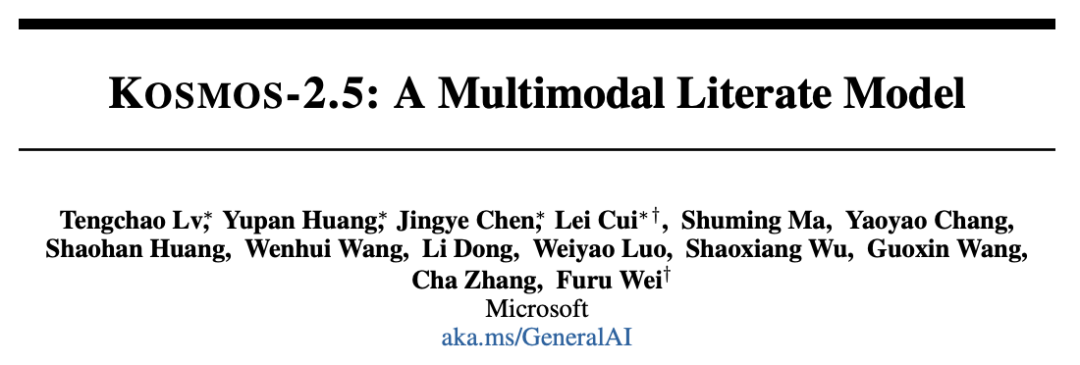 Paper address: https://arxiv.org/abs/2309.11419
Paper address: https://arxiv.org/abs/2309.11419
KOSMOS-2.5 is a multi-modal large-scale language model based on text-dense images. It is developed on the basis of KOSMOS-2 and highlights the multi-modal reading and understanding capabilities of text-dense images ( Multimodal Literate Model).
The proposed model highlights its excellent performance in understanding text-intensive images, bridging the gap between vision and text
At the same time, this also marks the evolution of the task paradigm, from the previous encoder-decoder architecture to a pure decoder architecture
KOSMOS-2.5 targets text-rich images Enables seamless visual and textual data processing to understand image content and generate structured text descriptions.
Figure 1: Overview of KOSMOS-2.5
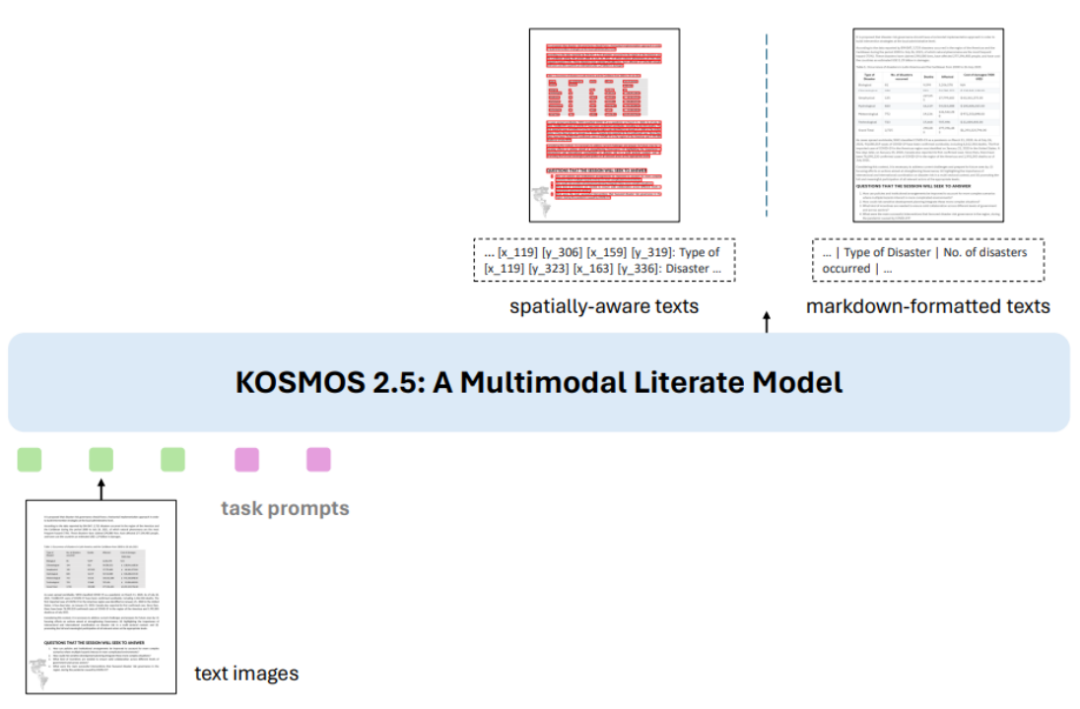 KOSMOS-2.5 is a multi-modal model , as shown in Figure 1, it aims to use a unified framework to handle two closely related tasks
KOSMOS-2.5 is a multi-modal model , as shown in Figure 1, it aims to use a unified framework to handle two closely related tasks
The first task involves generating spatially aware text blocks, i.e. simultaneously Generate the content and coordinate frame of the text block. The content that needs to be rewritten is: The first task involves generating a spatially aware text block, that is, generating the content of the text block and the coordinate box at the same time
#The second task involves using Markdown format Generate structured text output and capture various styles and structures
Figure 2: KOSMOS-2.5 architecture diagram
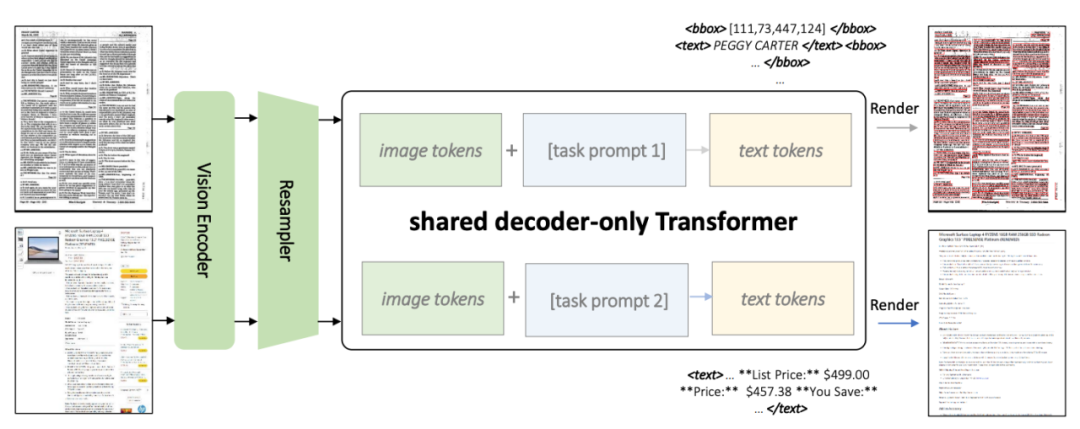 As shown in Figure 2, both tasks use a shared Transformer architecture and task-specific prompts
As shown in Figure 2, both tasks use a shared Transformer architecture and task-specific prompts
KOSMOS-2.5 will be based on ViT (Vision Transformer) vision The encoder is combined with a decoder based on the Transformer architecture, connected through a resampling module.
Figure 3: Pre-training data set
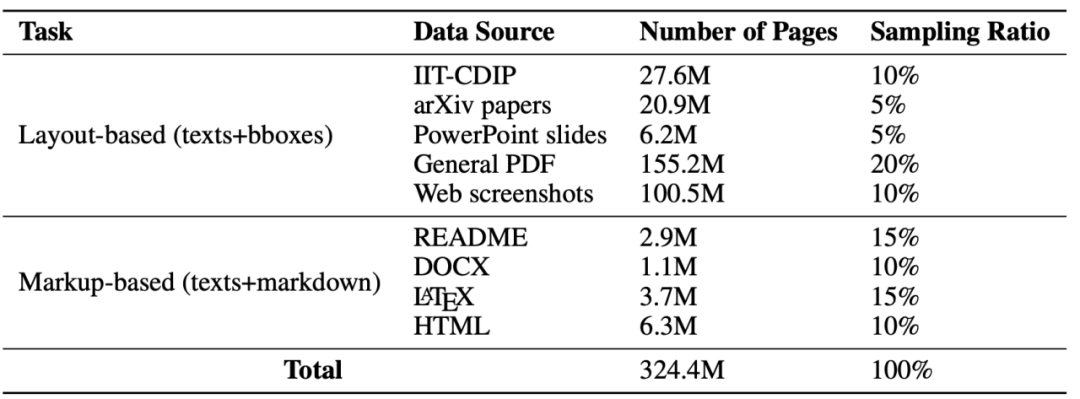 In order to train this model, the author prepared a huge The data set has a size of 324.4M, as shown in Figure 3
In order to train this model, the author prepared a huge The data set has a size of 324.4M, as shown in Figure 3
Figure 4: Example of training sample of text line with bounding box
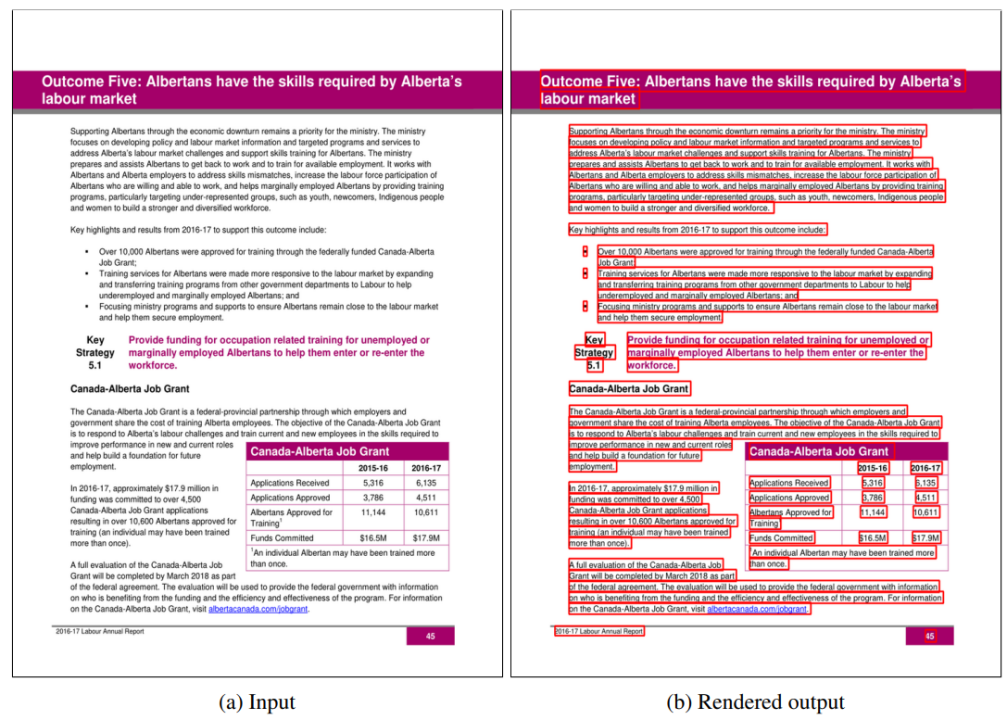
Figure 5: Example of training sample in Markdown format
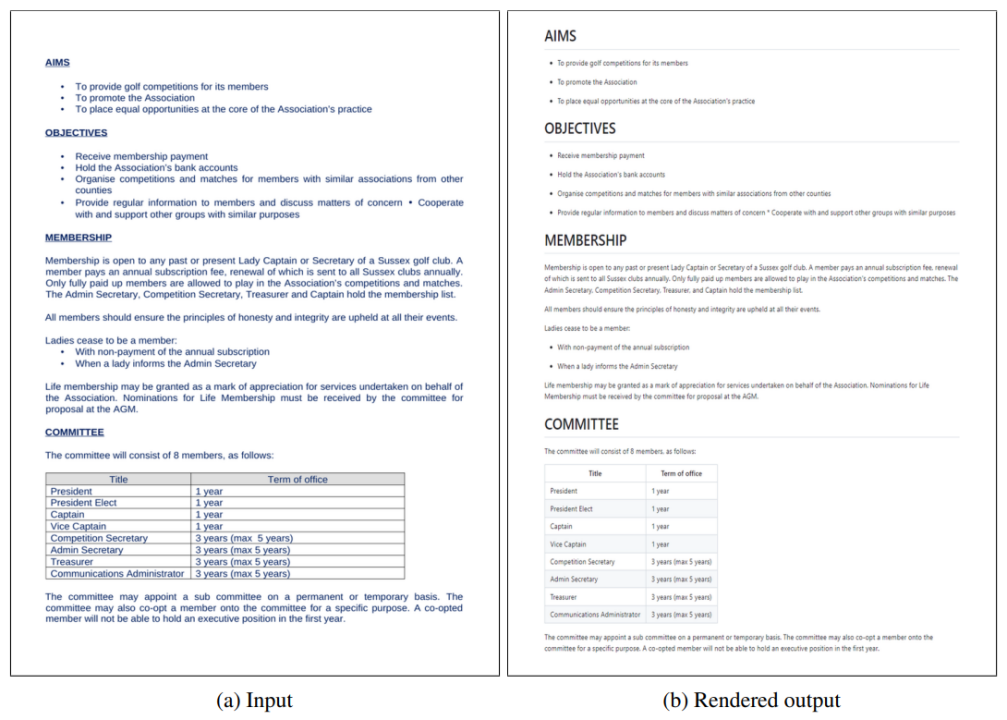 This data set contains various types A text-dense image, which includes lines of text with bounding boxes and plain text in Markdown format, Figures 4 and 5 are training sample example visualizations.
This data set contains various types A text-dense image, which includes lines of text with bounding boxes and plain text in Markdown format, Figures 4 and 5 are training sample example visualizations.
This multi-task training method improves the overall multi-modal capabilities of KOSMOS-2.5
 [Figure 6] End-to-end document-level text recognition experiment
[Figure 6] End-to-end document-level text recognition experiment
 Figure 7: Experiment on generating Markdown format text from images
Figure 7: Experiment on generating Markdown format text from images
As shown in Figures 6 and 7, KOSMOS-2.5 is evaluated on two tasks: end-to-end document-level text recognition and generation of Markdown formatted text from images.
KOSMOS-2.5 performs well in processing text-intensive image tasks, as experimental results demonstrate
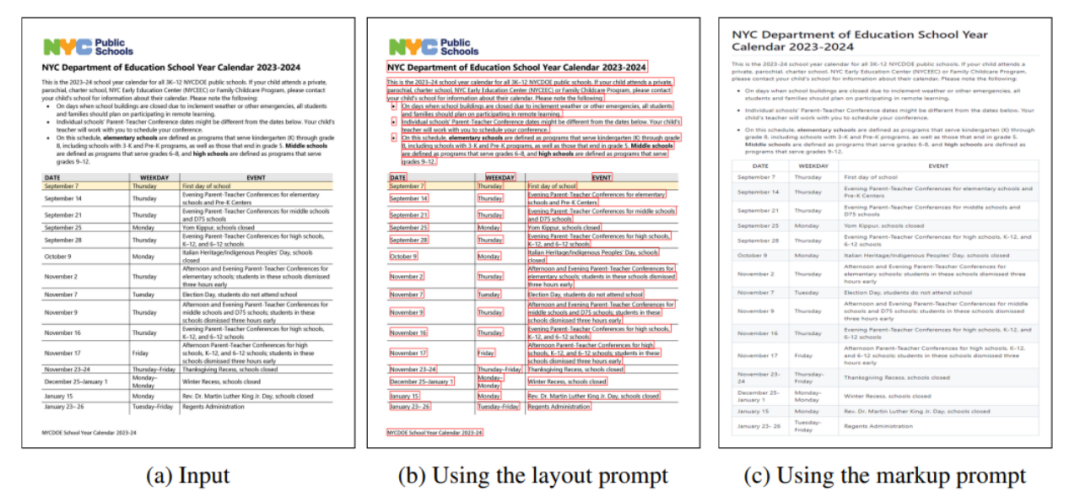 Figure 8: Input and output sample display of KOSMOS-2.5
Figure 8: Input and output sample display of KOSMOS-2.5
KOSMOS-2.5 shows promising capabilities in few-shot learning and zero-shot learning scenarios, making It becomes a versatile tool for practical applications in processing text-rich images. It can be considered as a versatile tool capable of effectively processing text-rich images and exhibiting promising capabilities in both few-shot and zero-shot learning situations
author pointed out that instruction fine-tuning is a promising method to achieve a wider application capability of the model.
In the broader research field, an important direction lies in further developing the ability to expand model parameters.
As tasks continue to expand in scope and complexity, scaling models to handle larger amounts of data is critical for the development of text-intensive multimodal models.
The ultimate goal is to develop a model that can effectively interpret visual and text data and successfully generalize across more text-intensive multi-modal tasks.
When rewriting the content, it needs to be rewritten into Chinese, and the original sentence does not need to appear
https://arxiv.org/abs/2309.11419
The above is the detailed content of The more words in the document, the more excited the model will be! KOSMOS-2.5: Multi-modal large language model for reading 'text-dense images'. For more information, please follow other related articles on the PHP Chinese website!

Hot AI Tools

Undresser.AI Undress
AI-powered app for creating realistic nude photos

AI Clothes Remover
Online AI tool for removing clothes from photos.

Undress AI Tool
Undress images for free

Clothoff.io
AI clothes remover

AI Hentai Generator
Generate AI Hentai for free.

Hot Article

Hot Tools

Notepad++7.3.1
Easy-to-use and free code editor

SublimeText3 Chinese version
Chinese version, very easy to use

Zend Studio 13.0.1
Powerful PHP integrated development environment

Dreamweaver CS6
Visual web development tools

SublimeText3 Mac version
God-level code editing software (SublimeText3)

Hot Topics
 The world's most powerful open source MoE model is here, with Chinese capabilities comparable to GPT-4, and the price is only nearly one percent of GPT-4-Turbo
May 07, 2024 pm 04:13 PM
The world's most powerful open source MoE model is here, with Chinese capabilities comparable to GPT-4, and the price is only nearly one percent of GPT-4-Turbo
May 07, 2024 pm 04:13 PM
Imagine an artificial intelligence model that not only has the ability to surpass traditional computing, but also achieves more efficient performance at a lower cost. This is not science fiction, DeepSeek-V2[1], the world’s most powerful open source MoE model is here. DeepSeek-V2 is a powerful mixture of experts (MoE) language model with the characteristics of economical training and efficient inference. It consists of 236B parameters, 21B of which are used to activate each marker. Compared with DeepSeek67B, DeepSeek-V2 has stronger performance, while saving 42.5% of training costs, reducing KV cache by 93.3%, and increasing the maximum generation throughput to 5.76 times. DeepSeek is a company exploring general artificial intelligence
 KAN, which replaces MLP, has been extended to convolution by open source projects
Jun 01, 2024 pm 10:03 PM
KAN, which replaces MLP, has been extended to convolution by open source projects
Jun 01, 2024 pm 10:03 PM
Earlier this month, researchers from MIT and other institutions proposed a very promising alternative to MLP - KAN. KAN outperforms MLP in terms of accuracy and interpretability. And it can outperform MLP running with a larger number of parameters with a very small number of parameters. For example, the authors stated that they used KAN to reproduce DeepMind's results with a smaller network and a higher degree of automation. Specifically, DeepMind's MLP has about 300,000 parameters, while KAN only has about 200 parameters. KAN has a strong mathematical foundation like MLP. MLP is based on the universal approximation theorem, while KAN is based on the Kolmogorov-Arnold representation theorem. As shown in the figure below, KAN has
 Hello, electric Atlas! Boston Dynamics robot comes back to life, 180-degree weird moves scare Musk
Apr 18, 2024 pm 07:58 PM
Hello, electric Atlas! Boston Dynamics robot comes back to life, 180-degree weird moves scare Musk
Apr 18, 2024 pm 07:58 PM
Boston Dynamics Atlas officially enters the era of electric robots! Yesterday, the hydraulic Atlas just "tearfully" withdrew from the stage of history. Today, Boston Dynamics announced that the electric Atlas is on the job. It seems that in the field of commercial humanoid robots, Boston Dynamics is determined to compete with Tesla. After the new video was released, it had already been viewed by more than one million people in just ten hours. The old people leave and new roles appear. This is a historical necessity. There is no doubt that this year is the explosive year of humanoid robots. Netizens commented: The advancement of robots has made this year's opening ceremony look like a human, and the degree of freedom is far greater than that of humans. But is this really not a horror movie? At the beginning of the video, Atlas is lying calmly on the ground, seemingly on his back. What follows is jaw-dropping
 AI subverts mathematical research! Fields Medal winner and Chinese-American mathematician led 11 top-ranked papers | Liked by Terence Tao
Apr 09, 2024 am 11:52 AM
AI subverts mathematical research! Fields Medal winner and Chinese-American mathematician led 11 top-ranked papers | Liked by Terence Tao
Apr 09, 2024 am 11:52 AM
AI is indeed changing mathematics. Recently, Tao Zhexuan, who has been paying close attention to this issue, forwarded the latest issue of "Bulletin of the American Mathematical Society" (Bulletin of the American Mathematical Society). Focusing on the topic "Will machines change mathematics?", many mathematicians expressed their opinions. The whole process was full of sparks, hardcore and exciting. The author has a strong lineup, including Fields Medal winner Akshay Venkatesh, Chinese mathematician Zheng Lejun, NYU computer scientist Ernest Davis and many other well-known scholars in the industry. The world of AI has changed dramatically. You know, many of these articles were submitted a year ago.
 Tesla robots work in factories, Musk: The degree of freedom of hands will reach 22 this year!
May 06, 2024 pm 04:13 PM
Tesla robots work in factories, Musk: The degree of freedom of hands will reach 22 this year!
May 06, 2024 pm 04:13 PM
The latest video of Tesla's robot Optimus is released, and it can already work in the factory. At normal speed, it sorts batteries (Tesla's 4680 batteries) like this: The official also released what it looks like at 20x speed - on a small "workstation", picking and picking and picking: This time it is released One of the highlights of the video is that Optimus completes this work in the factory, completely autonomously, without human intervention throughout the process. And from the perspective of Optimus, it can also pick up and place the crooked battery, focusing on automatic error correction: Regarding Optimus's hand, NVIDIA scientist Jim Fan gave a high evaluation: Optimus's hand is the world's five-fingered robot. One of the most dexterous. Its hands are not only tactile
 FisheyeDetNet: the first target detection algorithm based on fisheye camera
Apr 26, 2024 am 11:37 AM
FisheyeDetNet: the first target detection algorithm based on fisheye camera
Apr 26, 2024 am 11:37 AM
Target detection is a relatively mature problem in autonomous driving systems, among which pedestrian detection is one of the earliest algorithms to be deployed. Very comprehensive research has been carried out in most papers. However, distance perception using fisheye cameras for surround view is relatively less studied. Due to large radial distortion, standard bounding box representation is difficult to implement in fisheye cameras. To alleviate the above description, we explore extended bounding box, ellipse, and general polygon designs into polar/angular representations and define an instance segmentation mIOU metric to analyze these representations. The proposed model fisheyeDetNet with polygonal shape outperforms other models and simultaneously achieves 49.5% mAP on the Valeo fisheye camera dataset for autonomous driving
 Single card running Llama 70B is faster than dual card, Microsoft forced FP6 into A100 | Open source
Apr 29, 2024 pm 04:55 PM
Single card running Llama 70B is faster than dual card, Microsoft forced FP6 into A100 | Open source
Apr 29, 2024 pm 04:55 PM
FP8 and lower floating point quantification precision are no longer the "patent" of H100! Lao Huang wanted everyone to use INT8/INT4, and the Microsoft DeepSpeed team started running FP6 on A100 without official support from NVIDIA. Test results show that the new method TC-FPx's FP6 quantization on A100 is close to or occasionally faster than INT4, and has higher accuracy than the latter. On top of this, there is also end-to-end large model support, which has been open sourced and integrated into deep learning inference frameworks such as DeepSpeed. This result also has an immediate effect on accelerating large models - under this framework, using a single card to run Llama, the throughput is 2.65 times higher than that of dual cards. one
 Comprehensively surpassing DPO: Chen Danqi's team proposed simple preference optimization SimPO, and also refined the strongest 8B open source model
Jun 01, 2024 pm 04:41 PM
Comprehensively surpassing DPO: Chen Danqi's team proposed simple preference optimization SimPO, and also refined the strongest 8B open source model
Jun 01, 2024 pm 04:41 PM
In order to align large language models (LLMs) with human values and intentions, it is critical to learn human feedback to ensure that they are useful, honest, and harmless. In terms of aligning LLM, an effective method is reinforcement learning based on human feedback (RLHF). Although the results of the RLHF method are excellent, there are some optimization challenges involved. This involves training a reward model and then optimizing a policy model to maximize that reward. Recently, some researchers have explored simpler offline algorithms, one of which is direct preference optimization (DPO). DPO learns the policy model directly based on preference data by parameterizing the reward function in RLHF, thus eliminating the need for an explicit reward model. This method is simple and stable





